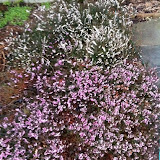Garden Bloggers' Bloom Day, March 2012
March Bloom Day already! Well, almost, I'm posting this a little early because I don't want to miss it.
The weather has been incredible, and the spring garden season is well underway, even here on Cape Cod, where we're normally several weeks behind the rest of New England. I do believe this is the first time I've seen daffodils before the middle of March - they can be pests in a mixed bed, but nothing beats them for cheerfulness at this time of year.

One of the most underused spring bloomers is the dainty (and hard to photograph) Cornus mas, a lovely small tree that does well in part shade. This one's got chartreuse foliage, and needs more sun than most. It's in a hot dry location, and has put up with less than perfect conditions pretty well. I love the tiny flowers, that usually open in late March.

Winter heath has been wonderful this year - the color gets more intense every day especially on the deep pinks:

This has been a great year for hellebores, too. Not only have they performed well, everyone's buzzing about them. Here's an old stand-by, a simple hybrid (aka Helleborus orientalis)

Also in bloom in my garden now: snowdrops, Hamamelis x intermedia 'Diane' and 'Arnold Promise', Viburnum x bodnantense 'Dawn', Helleborus (foetidus, x hybridus and niger), lots of crocus, Jasminum nudiflorum and winter aconite (both should be winding down now), and the lovely thug, Lonicera fragrantissima - winter honeysuckle. Nandina domestica kept its leaves this winter, and the berries are still stunning. A more complete series of photos of my garden from this winter is on my Picasa Web album:
Also, check out the rest of the Garden Bloggers' Bloom Day posts on the May Dreams Blog!
The weather has been incredible, and the spring garden season is well underway, even here on Cape Cod, where we're normally several weeks behind the rest of New England. I do believe this is the first time I've seen daffodils before the middle of March - they can be pests in a mixed bed, but nothing beats them for cheerfulness at this time of year.

One of the most underused spring bloomers is the dainty (and hard to photograph) Cornus mas, a lovely small tree that does well in part shade. This one's got chartreuse foliage, and needs more sun than most. It's in a hot dry location, and has put up with less than perfect conditions pretty well. I love the tiny flowers, that usually open in late March.

Winter heath has been wonderful this year - the color gets more intense every day especially on the deep pinks:

This has been a great year for hellebores, too. Not only have they performed well, everyone's buzzing about them. Here's an old stand-by, a simple hybrid (aka Helleborus orientalis)

Also in bloom in my garden now: snowdrops, Hamamelis x intermedia 'Diane' and 'Arnold Promise', Viburnum x bodnantense 'Dawn', Helleborus (foetidus, x hybridus and niger), lots of crocus, Jasminum nudiflorum and winter aconite (both should be winding down now), and the lovely thug, Lonicera fragrantissima - winter honeysuckle. Nandina domestica kept its leaves this winter, and the berries are still stunning. A more complete series of photos of my garden from this winter is on my Picasa Web album:
 |
| Winter20112012 |
Also, check out the rest of the Garden Bloggers' Bloom Day posts on the May Dreams Blog!
Labels: Bloom Day March 2012






